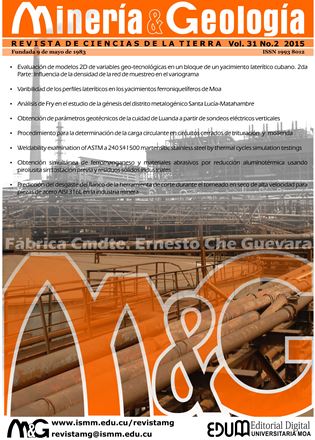Procedure for estimating the circulating load for closed grinding and milling circuits
Keywords:
mass balance, circulating load, closed circuit, Lagrange function, least square method, milling, grindingAbstract
With the objective to eliminate errors (residues) during the estimation of the circulating load for grinding and milling closed circuits, a procedure was developed to minimize the deviations and inconsistencies ’that occur in the distribution balance of granulometric classes of the product in the diagram by applying least square and Lagrange multipliers to balance equations. The proposed procedures is approved taking into consideration the testing data obtained by the author in 1993. The results show that the proposed procedure allows a better adjustment for the calculation of the circulating load. Based on its values the contents of the granulometric classes of the product are then re-estimated, which eliminates inconsistencies and errors in the content distribution of the granulometric classes produced during the sampling and sample processingDownloads
References
BOIZÁN, M. 1984: Optimización (sistemas estáticos). Editorial Oriente, Santiago de Cuba, 174 p.
COELLO-VELÁZQUEZ, A. L. 1993: Sobersenstobovanie tecnologii izmelchenia lateritovij rud. Dis. na izk. uch. step. Kan. tecn. nauk. Inst. Mejanobr. Saint Petersburg.
COELLO-VELÁZQUEZ, A. L.; MARRERO-RAMÍREZ, S. & HERNÁNDEZ-FLORES, A. 1994: Control de la carga interior del molino a través de terceros parámetros. Minería y Geología 11(1): 35-39.
COELLO-VELÁZQUEZ, A. L.; MENÉNDEZ-AGUADO, J. M. & LABORDE, R. 2008: Grindability of lateritic nickel ore in Cuba. Powder Technology 182(1): 113–115.
LABORDE, R.; COELLO-VELÁZQUEZ, A. L. & ANGULO, O. 2003: Racionalización del consumo de energía en la molienda de los minerales lateríticos. En: Seminario de Ingeniería Eléctrica SIE. UCLV. Las Villas, Cuba. 1-4.
WILLS, B. & NAPIER-MUNN, T. 2006: Mineral Processing Technology: An introduction to the practical aspect of ore treatment and mineral recovery. Seventh Edition. Elsevier Science & Technology Books, 450 p.
Published
How to Cite
Issue
Section
- Authors retain copyright and guaranteeing the right magazine to be the first publication of the work as licensed under a Creative Commons Attribution-NonCommercial that allows others to share the work with an acknowledgment of the work's authorship and initial publication in this journal.
- Authors may establish separate supplemental agreements for the exclusive distribution version of the work published in the journal (eg, place it in an institutional repository or publish it in a book), with an acknowledgment of its initial publication in this journal.
- Authors are allowed and recommended to disseminate their work through the Internet (e.g., in institutional telematic archives or on their websites) before and during the submission process, which can produce interesting exchanges and increase citations of the published work. (See The effect of open access)










